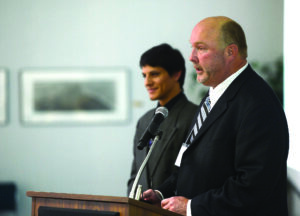CULLOWHEE – Western Carolina University students have provided representatives of local tourism interests in 26 Western North Carolina counties with data illustrating the impact of the travel and tourism industry on the economy of their particular counties.
Members of economic development organizations and chambers of commerce and owners and operators of private sector businesses in the tourism industry received the data in the form of “tourism economic fact sheets” presented Friday, April 11, at the inaugural “Tourism Works for Western North Carolina” conference presented by WCU’s College of Business and held at the North Carolina Center for the Advancement of Teaching.

Economist Steve Morse (foreground), director of the Hospitality and Tourism Program at Western Carolina University, and Robert L. Harris (background), a senior hospitality and tourism major from Cherokee, present findings about the economic impact of the travel and tourism business on 26 counties of Western North Carolina at a conference Friday, April 11. (WCU photo)
Students in a senior-level course titled “Hospitality and Tourism Strategies” collected and analyzed the data and prepared individualized fact sheets for counties from Cherokee in the extreme southwestern corner of North Carolina to Surry and Yadkin on the northwestern border with Virginia. The students analyzed county data from a study conducted by the N.C. Division of Tourism, Film and Sports Development.
The students’ professor, Steve Morse, an economist and director of WCU’s Hospitality and Tourism Program, told conference attendees that the study provided valuable information about the impact of tourist spending on the local economy – information they could take back with them to their home counties and use to garner additional support for the travel and tourism industry.
“We define tourists as either day-trippers or over-nighters who come to your county from more than 50 miles away for business or leisure purposes. We do not include people from within your county, because those are local people spending local dollars they would be spending anyway,” Morse said. “We also are looking at the average of tourist dollars spend on the average day. An average day is not the Fourth of July when everything is packed, and it’s not Wednesday of the third week in February when no one is visiting.”
In their analysis, the students also examined the role of tourists as “temporary taxpayers,” calculating how much the typical household in each of the 26 WNC counties saves in state and local taxes as a result of the taxes paid by visiting tourists, he said.
In addition to Morse and some of his students, presenters during the day included Will Tuttell executive director of the N.C. Division of Tourism Film and Sports Development; John Whisenant, director of tourism for the Tennessee Hospitality and Tourism Association; and representatives from Smoky Mountain Host, Blue Ridge Mountain Host and High Country Host and of the Blue Ridge National Heritage Area.
The students’ analysis revealed that tourism had the following economic impacts in 2012:
Some details from area counties are as follows:
* Cherokee County – Generated $35.33 million in direct tourist spending; produced $5.17 million in worker income; generated $3.71 million in combined state and local taxes; created 290 jobs; and reduced the average household local and state tax bill by $211.
* Clay County – Generated $12.29 million in direct tourist spending; produced $1.29 million in worker income; generated $1.82 million in combined state and local taxes; created 60 jobs; and reduced the average household local and state tax bill by $253.
* Graham County – Generated $24.84 million in direct tourist spending; produced $4.12 million in worker income; generated $2.73 million in combined state and local taxes; created 260 jobs; and reduced the average household local and state tax bill by $460.
* Haywood County – Generated $126.35 million in direct tourist spending; produced $23.71 million in worker income; generated $11.39 million in combined state and local taxes; created 1,310 jobs; and reduced the average household local and state tax bill by $325.
* Jackson County – Generated $69.55 million in direct tourist spending; produced $11.04 million in worker income; generated $8.38 million in combined state and local taxes; created 580 jobs; and reduced the average household local and state tax bill by $321.
* Macon County – Generated $135.76 million in direct tourist spending; produced $22.63 million in worker income; generated $16.69 million in combined state and local taxes; created 1,150 jobs; and reduced the average household local and state tax bill by $660.
* Swain County – Generated $293.06 million in direct tourist spending; produced $79.75 million in worker income; generated $22.85 million in combined state and local taxes; created 3,340 jobs; and reduced the average household local and state tax bill by $2,605.
– WCU





